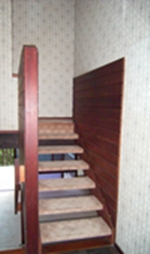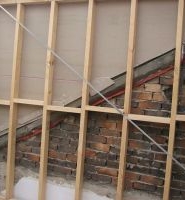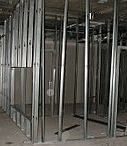Choosing the wall
First, if you don’t own the joint, best get permission for this project, then go for a walkabout round your place for a bit. Just looking, not thinking!
If you want to go bouldering, just about any wall will do, as long as you can’t touch the ceiling while standing on the floor, you will be able to boulder, although if you can touch it by jumping, it wont be as fun as if you can’t touch it even by jumping. Building your own indoor bouldering wall is also great for kids as they wont fall far, bringing parents of injured kids crashing through your front door to deal out the justice. This would be the case for most walls inside peoples houses, but don’t forget to checkout the garage or covered entertaining areas outside also.

Being a rock climber, danger is your middle name, and sometimes your surname, so if you are lucky enough to have some internal stairs, you might find that location has the highest walls in your house. Just imagine, you never have to trudge up those boring stairs again! Leap onto the wall and smear your way to heaven! Or as most people would call it, the first floor. Be aware of where you might fall, its hard to put crash pads onto stairs without creating a slippery slide with them. Our wall is over stairs but our rule is anything over reach height (bouldering) means the harness goes on and a buddy belays.
Just remember, building an indoor rock climbing wall cannot replace a staircase for every situation, so the removal of said stairs upon completion of the climbing wall would be foolish, but funny if you try to sell the place watching prospective buyers negotiate the wall to get to the bedrooms 🙂 Oh, and wives will struggle getting the washing baskets up and back, climbers need clean clothes too. Project 2 is a pulley system for that. The washing, not the wife.

OK, a wall has been found, now you have to make sure its suitable to build an indoor rock climbing wall on. Timber stud walls are the go, easiest to mount to, very strong because they usually attached top and bottom to other structural beams like floor and ceiling joists and bearers. If the wall you have chosen doesn’t actually touch a ceiling, like a dividing nib, but is attached to walls at each end, it should be OK, but I would ask a professional.
Concrete, bricks, masonry, stone etc would be my second choice. Good and strong, but harder to bolt onto, you could in fact build your rock climbing wall by bolting the holds directly onto a brick wall, hammer drilling is a noisy and dusty business, and if the wall is old, the mortar may not be as strong as is used to be. If the brick moves while drilling, I wouldn’t be real confident about relying on that brick staying put while you are swinging off it.

Typical metal or steel stud walls are very difficult to attach to and still guarantee any degree of strength. Sure, they might hold the wall up, but maybe not you attached to that wall as well. I would not recommend using a metal stud wall. Talk to a local builder if you think you have a steel framed house, they may have some advice on decent fixing options.
One way of checking the construction material of your place is to grab a torch and a ladder and poke your melon into the roofspace, if you see timber everywhere, and think it might hold you up, climb in! You are a climber after all! If you see what looks like metal wires or bars hanging down with clip things holding horizontal metal runners on top of the ceiling, don’t go up if you are not familiar with this, it will not hold you. If you have an attic, you are on your own, usually you can’t see through the floor and superman doesn’t need a climbing wall.
Hang on, people might get hurt, my advice is to find someone who knows about construction and get them to climb in, that way you wont be hurt if they fall through.
Now that someone is up there, only walk or crawl on the supports, unless you have a proper walkway in place, and try to position yourself above a wall (THE wall would be best). Hopefully you can see the top plate of the wall, and if it is shiny, its probably a metal framework, not good. If its bricks you see, pretty safe bet that the wall is brick, gooder. What if you see timber? Remember, don’t think too hard…
Oh yeah, it might have helped if you took something to hit with, like a small hammer, that way you can tap on the top of the wall and listen to what the material sounds like, a metal frame covered with years of dust might look like timber. Hammers are also a good defence for possums that might get angry about you being in their roof.
 Basically, if you don’t know or can’t be sure if a wall will be suitable to take more weight, not just the climbing wall itself, but people attached to climbing wall as well, ASK A PROFESSIONAL, I would suggest a professional builder as professional dancer is all well and good, but they may not be able to confirm what the wall is constructed of.
Basically, if you don’t know or can’t be sure if a wall will be suitable to take more weight, not just the climbing wall itself, but people attached to climbing wall as well, ASK A PROFESSIONAL, I would suggest a professional builder as professional dancer is all well and good, but they may not be able to confirm what the wall is constructed of.
Finally, if you are happy that you have a brick wall, get your hammer drill ready. Timber wall, brilliant! Go buy a stud finder, a magical tool that primarily detects framework (timber and metal), pipes and electrical cables sometimes. Yeah yeah, any “studs” nearby as well.
Being a rock climber. your in the DANGER ZONE!